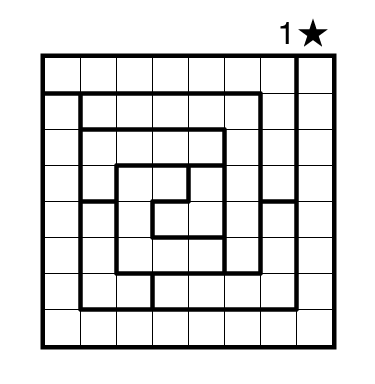Dr. Sudoku Prescribes #14 – Star Battle

or solve online (using our beta test of Penpa-Edit tools)
Theme: Downward Spiral
Rules: Standard Star Battle rules. One star per row, column, and region.
Answer String: For each row from top to bottom, enter the number of the first column from the left where a star appears. Enter these numbers as a single string with no separators.
Time Standard: Star Battle Master = 0:45, Expert = 2:15, Novice = 7:30
Solution: PDF
Note: Follow this link for other classic Star Battles and this link for Star Battle variations. If you are new to this puzzle type, here are our easiest Star Battles to get started on. More Star Battle puzzles can be found in The Art of Puzzles, in the book Star Battle by JinHoo Ahn, and in our beginner-friendly collection Intro to GMPuzzles by Serkan Yürekli.

7 mins 8 secs….solved through hit and trial..there must be some logic hidden..
A few general notes about Star Battle strategy, without going into too many details about this particular example yet. Note that it is more common for there to be two stars per row/column/region, so I’m trying to keep my remarks applicable to any number of stars.
1) It perhaps goes without saying, but you should mark squares where the stars cannot be, as well as the ones that must be stars. I usually put a dot in the center of squares that are confirmed empty.
2) There can be at most one star in any 2×2 region. Important special case, particularly for two-star puzzles: If there must be two stars inside a 2×3 rectangle, the stars are not in the middle pair of squares, but instead there must be one each along each side pair. (see 4 below)
3) Suppose that, for example, there are only three regions that ever intersect the right-hand three columns of a puzzle. Then all the stars for those three regions must actually be in those three columns, and any portions of those regions that stick outside those three columns must be empty. More generally, of course, this can be any number of rows or columns (including, in this puzzle, one column or row…).
3) If one region “pokes into” another region, it’s pretty common that the little part poking in must not contain any stars. Basically, if a square from one region is surrounded by squares from another region, putting a star there will eliminate a lot of squares in the other region, which may not leave enough room for the star(s) in that other region. (see center of this puzzle)
4) It is very common to narrow down the location of a star to one of two adjacent squares. In that case, we can mark all squares directly to the sides of that pair as empty (by which I mean squares that are adjacent along the longer edges of the 2×1 rectangle). It is also worth noting such pairs — I usually draw a line connecting the centers of the two adjacent cells, others shade the border between the cells dark. If you know that the star must be in one of three consecutive cells, you can mark the cells next to the center cell as empty, and I tend to mark the triples the same way (draw a line along the center of the region) — these are somewhat less common, though.
These are some great tips and I should find some way to link back to them in later puzzles this week that will need them much more.
A good start of Star Battle.
5 min.
So I think I screwed up and made 2:20, although that’s probably because I insist on myself to find a purely logical solution and without trial and error. (A former solve of this puzzle was somewhere around 1 minute, but that’s with trial and error.) Nice introductory puzzle.
ahhhh, i got to the last page, i need more star battles!
This has nothing to do with this puzzle specifically, it’s just the last one, please post more!
Online version: [EDIT: Removed as we added our own official link to post]